Resident Crews of the International Space Station (ISS)
![]()
ISS: Expedition 2 |
 |
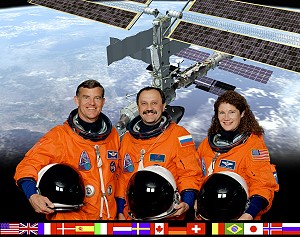
alternative crew photoalternative crew photoalternative crew photo |
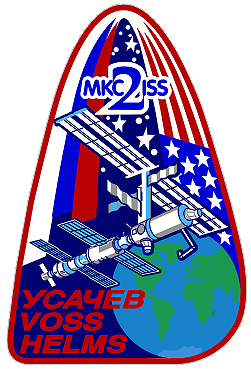 |
 |
|
![]()
Crew, launch- and landing data
| No. | Nation | Surname | Given names | Position | Spacecraft (launch) |
Launch date |
Launch time |
Spacecraft (landing) |
Landing date |
Landing time |
Mission duration |
Orbits |
| 1 | Usachyov | Yuri Vladimirovich | ISS-CDR | STS-102 | 08.03.2001 | 11:42:09.004 UTC | STS-105 | 22.08.2001 | 18:22:58.381 UTC | 167d 06h 40m 49s | 2635 | |
| 2 | Voss | James Shelton | Flight Engineer-1 | STS-102 | 08.03.2001 | 11:42:09.004 UTC | STS-105 | 22.08.2001 | 18:22:58.381 UTC | 167d 06h 40m 49s | 2635 | |
| 3 | Helms | Susan Jane | Flight Engineer-2 | STS-102 | 08.03.2001 | 11:42:09.004 UTC | STS-105 | 22.08.2001 | 18:22:58.381 UTC | 167d 06h 40m 49s | 2635 |
Backup Crew
| No. | Nation | Surname | Given names | Position |
| 1 | Onufriyenko | Yuri Ivanovich | ISS-CDR | |
| 2 | Walz | Carl Erwin | Flight Engineer | |
| 3 | Bursch | Daniel Wheeler | Flight Engineer |
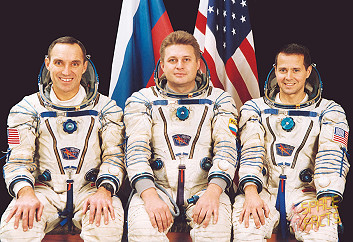 |
 |
Expedition Report
|
Expedition 2 launched with
STS-102 from
Cape Canaveral (KSC) and landed with
STS-105 on Cape
Canaveral (KSC). During this expedition, research facilities launched to the Space Station included a Human Research Facility, two EXPRESS (Expedite the Processing of Experiments to the Space Station) Racks, one of which contains the Active Rack Isolation System and the Payload Equipment Restraint System. They also prepared the Destiny laboratory to enable upcoming experiments to be conducted. The Expedition 2 officially began with undocking of Space Shuttle STS-102 on March 19, 2001 at 04:32:00 UTC. STS-102 docked on March 10, 2001 with the International Space Station. A new International Space Station crew - Expedition Two - , the first flight of an Italian-built Multipurpose Logistics Module (MPLM) and the first scientific rack for the U.S. laboratory Destiny highlighted the STS-102 mission (ISS-07-5A.1 MPLM Leonardo) of Discovery. The crew changeout was the first for the ISS. The Leonardo Multi-Purpose Logistics Module (MPLM), which was built by the Italian Space Agency (ASI), was the first of three such pressurized modules that serve as the International Space Station's "moving vans", carrying laboratory racks filled with equipment, experiments and supplies to and from the International Space Station aboard the space shuttle. The cylindrical module was about 6.4 meters (21 feet) long and 4.6 meters (15 feet) in diameter. It weighed about 9,000 pounds (almost 4.1 metric tons). It could carry up to 20,000 pounds (9.1 metric tons) of cargo packed into 16 standard space station equipment racks. The unpiloted, reusable logistics module functioned as both a cargo carrier and a space station module when it is flown. In order to function as an attached station module as well as a cargo transport, Leonardo contained components that provide some life support, fire detection and suppression, electrical distribution and computer functions. Eventually, the modules also carried refrigerator freezers for transporting experiment samples and food to and from the station. On this mission, Leonardo was mounted in the space shuttle's payload bay for launch and remained there until after docking. Once the shuttle was docked to the station, the shuttle's robotic arm removed Leonardo from the payload bay and berthed it to the Unity Module on the ISS. During its berthed period to the station, system racks and individual components were transferred to the ISS. After Leonardo was unloaded, used equipment and trash was transferred to it from the station for return to Earth. The Leonardo logistics module then was detached from the station and positioned back into the shuttle's cargo bay for the trip home. When in the cargo bay, Leonardo was independent of the shuttle cabin, and there was no passageway for shuttle crewmembers to travel from the shuttle cabin to the module. Leonardo was filled with equipment and supplies to outfit the U.S. laboratory Destiny, which was carried to the International Space Station on STS-98 in February 2001. Of the 16 racks the module could carry, this mission brought six ISS system racks, three resupply stowage racks, four resupply stowage platforms, and the first scientific experiment rack. The crew transfer, the first for the station, was among the mission's top priorities. Expedition One Commander William Shepherd, Soyuz Commander Yuri Gidzenko and Flight Engineer Sergei Krikalyov were replaced by Expedition Two Commander Yuri Usachyov and Expedition Two Flight Engineers Susan Helms and James Voss. The transfer took place in a carefully orchestrated, one-at-a-time process that ensured three current members of the station crew were able to come home, at any time during the switch, aboard the Soyuz spacecraft attached to the station. Expedition Two crewmembers officially joined the station when they installed their seat liners in the Soyuz. Equipment transfer to the ISS and outfitting Destiny for the arrival of the Space Station Remote Manipulator System (SSRMS), the space station's robotic arm on STS-100 (6A) also was among the major priorities of Discovery's flight. Much of that equipment was transferred from the Multi-Purpose Logistics Module (MPLM), a pressurized moving van module designed to be taken into orbit, attached to the space station, and then, after unloading, brought back to the orbiter's cargo bay for return to Earth. The Italian-built MPLM, named Leonardo, was attached to the nadir, or Earth-facing, berthing port of the Unity node. Before that could happen a docking port, Pressurized Mating Adaptor 3 (PMA 3), must be removed from that berthing port. It will be attached to an adjacent berthing port on Unity's left side. The PMA 3 move was made during the spacewalk by James Voss and Susan Helms. The spacewalk was preceded by transfer of a spacesuit and two Simplified Aids for EVA Rescue (SAFER) devices from the station to the shuttle shortly after docking. Leonardo brought six systems racks to the station. Among them were two robotic workstation racks for control of the station's robotic arm and the four cameras mounted on it. Two were DC-to-DC Converter Units (DDCUs) which convert electrical power from the station's solar arrays to a form usable by station systems and experiments. One was the U.S. Lab Avionics 3 rack with components supporting both the Ku-Band communications system and the command and control system. The sixth was a Crew Health Care System rack. The Ku-Band is used for high data rate communications, including downlink of television pictures. The command and control system is operated from the U.S. laboratory and controls the attitude or orientation in space of the station, using four 800-pound gyroscopes mounted in the Z1 Truss of the ISS. Among racks transferred by the ISS crew was the Human Research Facility, the first scientific rack to be brought to the station. While it is significant in that it marked the beginning of major research capability on the station, its transfer was a lower priority than transfer of the six systems racks, the three resupply stowage racks and the four resupply stowage platforms from Leonardo - indeed it were the last of the racks to be transferred. While the experiment rack was activated and checked out, the Ku-Band and a communications outage recorder must working to support data recording and downlink. After transfer of the Human Research Facility, transfer of materials into Leonardo began. Such materials - batteries at the end of their designed lives, used filters, packing materials and garbage are examples - were returned to Earth. Other priorities included activation and checkout of transferred racks, operation of the IMAX camera by the station crew and a series of tests supporting station assembly. With STS-102 the first time the Multi Purpose Logistics Module (Leonardo) was used to bring supplies to the station. The Discovery also carried an Integrated Cargo Carrier (ICC). The ICC had the External Stowage Platform-1 (ESP-1) mounted on its underside. ESP-1 was placed on the port side of 'Destiny' as a storage location for ORUs. The Integrated Cargo Carrier (ICC) was a two-part structure consisting of a waffle-like aluminum box-beam pallet and keel-yoke assembly. It was installed in the cargo bay of the space shuttle orbiter, to expand the shuttle's capacity to transport unpressurized cargo. The External Stowage Platform (ESP) was installed during the second spacewalk on the port aft trunnion on Destiny. It was a temporary home for orbital replacement units-spares stowed on the ESP and available to replace vital equipment. Space walking astronauts also hooked up cables to provide power to the orbital replacement units stowed there. The first EVA by Susan Helms and James Voss was performed on March 11, 2001 (8h 55m - new U.S. spacewalk record) to prepare PMA-3 for repositioning from the berth to the port side of Unity to make room for Italian built Multi-Purpose Logistics Module Leonardo, which was later attached to the ISS. James Voss and Susan Helms helped relocate Pressurized Mating Adaptor 3 (PMA-3) from the lower berthing port on the Unity node to an adjacent berthing port on Unity's left side. That was done so the Multipurpose Logistics Module (MPLM) could be docked to the common berthing mechanism of the lower port. James Voss and Susan Helms started their spacewalk jobs by preparing for the PMA-3 move. This included moving a gap spanner tether and disconnecting eight cables. Next, James Voss removed the port Early Communications System antenna from the port side of the Unity Node and took it to the airlock. James Voss, on the end of Discovery's robotic arm being operated by Andrew Thomas (who shared arm duties with Pilot James Kelly), and Susan Helms then removed the Lab Cradle Assembly (LCA) from the Integrated Cargo Carrier in Discovery's cargo bay and installed it on the U.S. laboratory Destiny's aft zenith trunnion. During STS-100 the 300-pound (136 kg), four-foot square (0.4 square meter) LCA was used to secure the Launch Deployment Assembly of the station's robotic arm. On STS-110 it was used to permanently secure the S0 truss segment to Destiny, and became the structural interface between the station and the main truss. The space walkers run cables to Destiny for power and data and removed a thermal cover from the LCA. They then swap places, with Susan Helms moving to the foot support on the arm and James Voss becoming the free-floater. They returned to the Integrated Cargo Carrier pallet and removed the Rigid Umbilical, a wiring harness to take power, data and video between Destiny and the station's robotic arm. They transferred and installed the RU to the forward, lower side of Destiny near the Power & Data Grapple Fixture, an attachment point on Destiny for the station arm. There they removed a protective shield and connect cables. The second and final EVA by Paul Richards and Andrew Thomas occurred on March 13, 2001 (6h 21m) in which they installed a stowage platform and attached an ammonia coolant pump on the platform. Also, cables were connected, which will be needed for the Canadian built robotic arm, which will be attached to the station in a future flight. Andrew Thomas and Paul Richards removed the External Stowage Platform (ESP) from the Integrated Cargo Carrier pallet in the cargo bay and installed it on the port aft trunnion on Destiny. With James Kelly on the arm, they hooked up cables that provide heater power to orbital replacement units - spares stowed on the ESP and available to replace vital equipment. Andrew Thomas then maneuvered back to the pallet and removed the Pump and Flow Control Subassembly, the first of such spares to be left on the ESP. He transferred it to the ESP and installed it there. The Pump and Flow Control Subassembly is a 250-pound (113.4 kg) device that pumps and controls valves for ammonia coolant flow. Meanwhile, Paul Richards turned his attention to the LCA installed on the first spacewalk. He performed a ready-to-latch indicator test on each of the four indicators on the LCA. Paul Richards then closed two circuit interrupt devices to bring power to the DC-to-DC Conversion Units inside Destiny. Paul Richards then began a photo-documentation survey of the worksite, before he and Andrew Thomas did the post-spacewalk cleanup and go back into the airlock. On March 19, 2001 STS-102 left the space station and returned home. With STS-100 the next Space Shuttle docked with the International Space Station on April 21, 2001. The highest priority objectives of STS-100 (ISS-08-6A MPLM Raffaello) were the installation, activation and checkout of the Canadarm2 robotic arm on the station. The operation of the arm is critical to the capability to continue assembly of the International Space Station, and was also necessary to attach a new airlock to the station on the subsequent shuttle flight, mission STS-104. A, final component of the Canadarm is the Mobile Base System (MBS), installed on board the station during the STS-111 flight. The Canadarm2 is a space robotic arm of unprecedented capabilities. The station arm will be able to move more than three times as much mass as the shuttle's robotic arm - a mass greater than even a 100-ton space shuttle. The station arm also will have an amazing capability to move end-over-end about the station's exterior, in inchworm fashion, using either end to manipulate cargos. It can provide electrical power and make computer connections with the things it moves and has greater flexibility than the shuttle arm. It measures 57.7 feet (17.59 meters), about 7 feet (2.13 meters) longer than the shuttle arm, and it is designed to be disassembled and repaired in space if necessary. Other major objectives for Endeavour's mission were to berth the Raffaello logistics module to the station, activate it, transfer cargo between Raffaello and the station, and reberth Raffaello in the shuttle's payload bay. Raffaello was the second of three Multi-Purpose Logistics Module (MPLM) developed by the Italian Space Agency (ASI) that was launched to the station. The Leonardo module was launched and returned on the previous shuttle flight, STS-102, in March 2001. Endeavour became the first shuttle to visit the station's second expedition crew of Commander Yuri Usachyov and Flight Engineers James Voss and Susan Helms since they began their stay aboard the outpost in March 2001. The two crews did not greet one another in person until Flight Day 5 of the mission due to a lower cabin pressure that was maintained aboard the shuttle as part of the spacewalk preparations. The crews, however, used an outer station compartment as a type of "airlock" to allow them to exchange a few items early on despite the differing cabin pressures on each spacecraft. The first EVA was performed by Chris Hadfield and Scott Parazynski on April 22, 2001 (7h 10m) to install the Canadian built robotic arm (57.7 foot = 17.59 meters long) called: Canadarm2. Chris Hadfield was the first Canadian in free space. As Chris Hadfield and Scott Parazynski were donning their spacesuits on Endeavour's lower deck, in the aft cockpit, Jeffrey Ashby powered up the shuttle's robotic arm. Jeffrey Ashby used the shuttle arm to lift a Spacelab Pallet holding the station arm and the UHF communications antenna from the shuttle's cargo bay. He then maneuvered the pallet, with the Canadarm2 and antenna attached, to latch to a cradle affixed to the station's Destiny lab. At that point, Chris Hadfield and Scott Parazynski left the shuttle's airlock and began their spacewalk. Chris Hadfield and Scott Parazynski connected cables that will feed the initial electrical power, computer commands and video between the station and the Canadarm2. They next installed and deployed an Ultra-High Frequency (UHF) communications antenna that enabled the station to conduct future spacewalk communications and that improved future shuttle-station communications. Then they released launch bolts that held the Canadarm2 secure during its trip to orbit, unfolded the arm and prepared it for control from inside the station. During much of the first spacewalk, Chris Hadfield worked from a foot platform attached to the shuttle's robotic arm, controlled by Jeffrey Ashby. Scott Parazynski worked free-floating or from fixtures attached to the station. For the first task, connecting the initial station power, command and video cables to the arm, Chris Hadfield released a set of cables from restraints on the Spacelab Pallet to which the arm was attached. The four cable connections to be made will provide space station power, commanding and video to and from the Flight Support Equipment Grapple Fixture (FSEGF) on the pallet, which serves as the arm's initial base. Scott Parazynski connected the cables to the station's Destiny lab, enabling the arm to later be controlled from a Robotics Work Station within the lab. Next, the two spacewalkers removed the UHF antenna from its launch restraints on the pallet, and Chris Hadfield held it while Jeffrey Ashby maneuvered him to the position where the antenna was installed on the station. Scott Parazynski bolted the antenna to the station and connected cables between the new system and the complex. The antenna's booms then were deployed by the spacewalkers. Then, the spacewalkers turned their attention back to the robotic arm. They removed several insulating blankets from the arm and pallet and verified that station electrical power was supplied to the arm before beginning to release bolts that held the arm in place during launch. They sequentially released 32 smaller bolts called jackbolts that held tight eight large, four-foot-long "superbolts" that secured the arm in place on the pallet. As they were removed, the long superbolts were placed into a "quiver", a container that held them securely for a return to Earth on the pallet. Once the launch restraint bolts were removed, Jeffrey Ashby maneuvered Chris Hadfield at the end of the shuttle's arm to begin unfolding the station arm. As each of two booms were unfolded, the spacewalkers tightened bolts, called Expandable Diameter Fasteners, that made the booms rigid. The Canadarm2 was ready for its first operations once this spacewalk was completed, operations that had it "walk off" the Spacelab Pallet on the next day of the mission. The hatches were fully opened and the shuttle and station crews greeted one another for the first time on Flight Day 5. Inside the Destiny lab, Susan Helms and James Voss, assisted by Chris Hadfield and Scott Parazynski, worked at the control center for the newly attached station arm, powering it up and moving the Canadarm2 for the first time. They maneuvered the new arm, checking its operation and finally latching a free end to a fixture on the station's exterior. The other end remained latched to a fixture on the pallet. Also on Day 5, Scott Parazynski and Umberto Guidoni used the shuttle's robotic arm to lift the Raffaello logistics module from the cargo bay and maneuvered it to a berthing port on the station's Unity module, where it was unloaded during the following days. At the end of Day 5, the hatches between Endeavour and the station were closed again in preparation for another spacewalk. The second and final EVA by Chris Hadfield and Scott Parazynski occurred on April 24, 2001 (7h 40m) to connect the Power and Data Grapple Fixture circuits for the robotic arm. Their second spacewalk began with Chris Hadfield and Scott Parazynski opening a panel on the lab's exterior and Scott Parazynski then connecting power, computer and video cables for the Destiny lab fixture to which one end of the Canadarm2 then was attached. Scott Parazynski made eight cable connections to prepare the arm to "switch ends" using the lab fixture, called a Power and Data Grapple Fixture (PDGF), as its base and the end attached to the pallet as its free end. While Scott Parazynski was working with the connections, Chris Hadfield climbed to the station's Unity module and removed an Early Communications System antenna, a box-shaped, 100-pound (45.4 kg) antenna that was used as part of an early station system that is no longer needed. The antenna must be removed from Unity to clear the way for the arrival of the station airlock launched on the STS-104 space shuttle mission. Chris Hadfield carried the removed antenna back to Endeavour's payload bay, where it was taken into the cabin at the end of the spacewalk. Once the station crew had confirmed that power was provided to the arm through the connections made by Scott Parazynski, Chris Hadfield began disconnecting the four power, command and video cables that were installed between the pallet and station during the first spacewalk. The four cables provided the initial power, command and video to the arm but were now no longer be required and must be removed to allow the Spacelab Pallet to be unlatched from the station and eventually returned to the shuttle bay. While Chris Hadfield was disconnecting those cables, Scott Parazynski removed a Video Signal Converter (VSC) from the Spacelab Pallet that was now no longer needed for the arm's operation. The unit was stowed aboard the station as a spare. The two spacewalkers then began stowing some of their tools while they monitored the movement of the Canadarm2, controlled from inside the station by station crew member Susan Helms, as it "switches ends". Now using the fixture on the exterior of Destiny as its base, the arm lifted the Spacelab Pallet, now attached to the arm's free end, and maneuvered to a parked position where it was locked in place overnight. The arm's move also cleared the way for the final spacewalk task, attaching a spare piece of station electronics equipment to an external stowage platform on the exterior of the Destiny lab. Working from a foot platform attached to the end of the shuttle's robotic arm, Scott Parazynski removed the spare piece of electronics, a critical part for the station's electrical system called a Direct Current Switching Unit, from a platform in the shuttle bay. Jeffrey Ashby then maneuvered Scott Parazynski to the exterior of Destiny, where, assisted by Chris Hadfield, he secured the spare unit to the stowage platform, in place for use by future crews if needed. Following the two spacewalks, the Endeavour and station crews engaged in the first dual robotic arm operations ever conducted in space, a "handshake" between the Canadian robotic arms for the shuttle and station that served to relocate the pallet in the shuttle cargo bay. Inside the station's Destiny lab, Susan Helms powered up the station's arm, with the pallet still attached to its free end, and maneuvered the pallet to a position high above the shuttle, within reach of the shuttle arm. The station arm's maneuvers continued checks of the new arm with a payload attached. Then, aboard Endeavour, Chris Hadfield, assisted by Scott Parazynski, powered up the shuttle arm. Chris Hadfield assisted with the operation of both arms at times during the day. Once the station arm had the pallet properly positioned, Susan Helms locked it in place while Chris Hadfield, at the controls of the shuttle arm, latched onto it. Susan Helms then released the pallet from the station arm and Chris Hadfield maneuvered the pallet, now affixed to the end of the shuttle arm, back to a position in Endeavour's payload bay to be latched for the return to Earth. Susan Helms, Chris Hadfield and James Voss performed further checks of the station arm's operation. The checks included a "dry run" where the arm will be maneuvered in the same positions that will be required to lift a new station airlock from the shuttle's bay and install it on the station's Unity module on the next space shuttle flight (STS-104), and the crews continued unloading and reloading - with trash, unnecessary equipment, and Earth-bound items - the Raffaello logistics module. Commander Kent Rominger fired Endeavour's small steering jets intermittently for about an hour to boost the shuttle and station altitude by several miles. Then, the shuttle and station crews said a final farewell to one another and closed hatches between the spacecraft. On April 29, 2001 Endeavour backed away from the ISS to a distance of about 450 feet (137.2 meters), where pilot Jeffrey Ashby began a close flyaround of the station, making almost three-fourths of a circle around it. Jeffrey Ashby passed directly above the station, then behind, then directly underneath it. At that point, Jeffrey Ashby fired Endeavour's jets for final separation from the station. The flyaround was completed a little over an hour after undocking. Soyuz TM-32 was the first taxi crew to the ISS. Following a two-day solo flight Soyuz TM-32 docked with the ISS on April 30, 2001 and common work with the second expedition was performed. Dennis Tito (USA) paid as the first space tourist 20 Million Dollar for his flight to the ISS. The main purpose was to exchange the Soyuz spacecraft (Soyuz TM-31). Soyuz TM-32 served as a new lifeboat. Soyuz TM-32 cosmonauts undocked with the Soyuz TM-31 spacecraft on May 06, 2001 and landed in Kazakhstan. Progress M1-6 was launched on the maiden flight of the Soyuz-FG carrier rocket at 22:32:40 UTC on May 20, 2001. The spacecraft docked with the Aft port of the Zvezda module at 00:23:57 UTC on May 23, 2001. Progress M1-6 carried supplies to the International Space Station, including food, water and oxygen for the crew and equipment for conducting scientific research. It remained docked for three months before undocking at 06:02 UTC on August 22, 2001 to make way for Progress M-45. It was deorbited at 09:00 UTC on the same day, burning up in the atmosphere over the Pacific Ocean, with any remaining debris landing in the ocean at around 09:50 UTC. James Voss and Yuri Usachyov performed a first station-based spacewalk (SEVA) on the ISS on June 08, 2001 (19 minutes) to install a docking cone assembly for the arrival of a new Russian built docking compartment, scheduled for late 2001. Several technical problems with the Canadian built remote manipulator system (Canadarm2) occurred. The resident crew performed scientific work onboard the station (18 different science experiments). Two cargo spacecrafts were unloaded. On July 14, 2001 STS-104 docked with the International Space Station. Primary objectives of mission STS-104 (ISS-10-7A Joint Airlock) was to install the Quest Joint Airlock. The Joint Airlock is 20 ft (6.1 m) long, 13 ft (4.0 m) in diameter and weighs 6.5 short tons (5.9 metric tons). The Joint Airlock is a pressurized flight element consisting of two cylindrical chambers attached end-to-end by a connecting bulkhead and hatch. It should give the ISS resident crews the possibility to perform EVAs without using a Space Shuttle airlock. The airlock was a critical space station element because of design differences between American and Russian spacesuits. American suits did not fit through Russian-designed airlocks. During a series of integration tests, the Russian suits were connected to the airlock to assure that they worked together. The airlock was specially designed to accommodate both suits, providing a chamber where astronauts from every nation can suit up for spacewalks to conduct science experiments and perform maintenance outside the station. The shuttle and station crews opened hatches and transferred some equipment and supplies, including water bags to the ISS Expedition 2. They then closed the hatches and Atlantis' cabin pressure was lowered to 10.2 pounds per square inch in preparation for the next day's spacewalk. The first EVA was performed by Michael Gernhardt and James Reilly on July 14, 2001 (5h 59m) to install Joint Airlock Module ("Quest") and attaching two high pressure oxygen tanks. During the first spacewalk the space walkers assisted as Susan Helms, using the station's robotic arm, lifted the new station airlock from Atlantis' payload bay and attached it to a port on the station's Unity connecting module. During much of the first spacewalk, James Reilly worked from a foot platform attached to the end of the shuttle's robotic arm, operated by Janet Kavandi. The first major task for the spacewalkers was for Michael Gernhardt to remove an insulating cover, nicknamed the "shower cap", from the airlock's Common Berthing Mechanism, the mechanism that will attach to Unity, while the airlock is in the payload bay. Michael Gernhardt also removed protective covers from the berthing mechanism's seals. The "shower cap" and seal covers were later stowed by the spacewalkers in a tool locker in Atlantis' payload bay for the trip back to Earth. Next, Michael Gernhardt disconnected a cable that provided shuttle electrical power to heaters on the airlock, called Launch To Activation or LTA heaters. Then James Reilly took the disconnected power cable and the removed airlock covers to a Tool Stowage Assembly (TSA) on the starboard side of the shuttle's payload bay to stow them. With the power cable between the shuttle and new airlock disconnected, Susan Helms began to latch the station's Canadarm2 onto a fixture on the new airlock. While Susan Helms and James Voss lifted the airlock from Atlantis' cargo bay and maneuvered it into position to attach to the Unity module, Michael Gernhardt and James Reilly had to wait inside the still-depressurized shuttle airlock, recharging their spacesuits by connecting to air and power from the shuttle. As Susan Helms worked with the station's arm, Janet Kavandi maneuvered the shuttle's arm into positions to provide television camera views to assist Susan Helms. Once the station airlock was poised high above the shuttle payload bay only a few feet from its attachment point on the station, Michael Gernhardt and James Reilly left the shuttle's airlock. The two spacewalkers provided on-the-spot observations for Susan Helms to assist with aligning the airlock as it was attached to Unity. Once the new airlock was attached to the station, Michael Gernhardt then connected a cable that will provide station power to the new component, the final major task for the spacewalk. After an overnight Airlock leak check, the next day's activities were largely devoted to airlock activation. Tasks included removing Common Berthing Mechanism motor controllers and connecting remaining utilities in the vestibule linking Unity with the airlock. Crewmembers entered the airlock to do more activation tasks, stow some equipment and check out the oxygen and nitrogen activities. The internal hatches between the shuttle and station were closed so Atlantis' cabin pressure could lowered in preparation for the second spacewalk. The second EVA was conducted by Michael Gernhardt and James Reilly on July 18, 2001 (6h 26m) to mount one oxygen and one nitrogen tank. The major objective of the second spacewalk was to attach and connect two - one oxygen and one nitrogen - of four oxygen and nitrogen tanks to the exterior of the new station airlock. The remaining two tanks were installed during the mission's third spacewalk. During the second spacewalk, Michael Gernhardt was tethered to the end of the shuttle's robotic arm for much of the work. Susan Helms was operating the station's arm to lift the tanks from the shuttle's payload bay and maneuvered them to the new airlock on the station. As the spacewalk began, Susan Helms latched the station arm onto the first tank, an oxygen tank, in Atlantis' payload bay. After the station arm was latched onto the tank, Michael Gernhardt released latches that hold it in place in the shuttle for launch. Susan Helms then lifted it from the shuttle bay and maneuvered it to the new station airlock. After releasing the latches, Michael Gernhardt got on the shuttle's robotic arm and Janet Kavandi flew him up to the station airlock. Meanwhile, James Reilly installed foot platforms and guideposts at the station airlock in preparation for installing the tank. When Susan Helms had moved the tank into position near the airlock, Michael Gernhardt and James Reilly, both working in foot platforms on the station's exterior, took the tank from the arm as Susan Helms released it. The spacewalkers then latched it into place on the airlock exterior, clamping it to some of the "towel bars" installed on the first spacewalk and using guideposts installed by James Reilly to ensure that the tank is properly aligned. Michael Gernhardt then connected hoses from the tank to the airlock. The same tasks were basically repeated to lift the second tank, a nitrogen tank, from the shuttle's cargo bay and install it onto the station airlock, although some foot platforms had to be repositioned. Then, while James Reilly finished connections for the second tank, Michael Gernhardt installed insulating covers on several airlock fixtures, including the four pins that helped latch the airlock in place during its time in the shuttle bay and the grapple fixture held by the station's robotic arm to attach the airlock to the station. The next day some equipment and supplies was transferred, including the Protein Crystal Growth - Enhanced GN2 Nitrogen Deware experiment. The third and final EVA (using first time the new airlock Quest) was again performed by Michael Gernhardt and James Reilly on July 20, 2001 (4h 01m) to attach the final nitrogen tank. The primary objective of the third spacewalk was to install the final two tanks - one oxygen and one nitrogen - on the exterior of the new station airlock. The task was basically a mirror of the procedures used during the second spacewalk to remove the first two tanks from the shuttle's payload bay and install them on the airlock exterior. In addition to installing the final two tanks, the spacewalkers connected a cable to the airlock that will enable communications with Russian spacesuits during future station spacewalks. They also installed several handholds on the airlock exterior and installed insulating covers over grapple fixtures on the newly installed air tanks. Atlantis backed away from the ISS on July 22, 2001 to a distance of about 450 feet (137.2 meters), where pilot Charles Hobaugh began a close flyaround of the station, circling the complex almost one and a quarter times. Charles Hobaugh passed a point directly above the station, then behind, then underneath, then in front and then reached a point directly above the station for a second time. At that point, passing above the station for a second time, Charles Hobaugh fired Atlantis's jets for final separation from the station. The Advanced Astroculture (Advasc) was the first plant growth facility installed in the ISS. It had two middeck lockers and built on a smaller experiment flown on eight previous space flights on the space shuttle and on space station Mir. Objectives are (1) to determine whether Arabidopsis, a member of the Brassica plant family that includes species such as cabbage and radishes, can complete its seed-to-seed life cycle in microgravity; (2) to determine the impact of microgravity on the gene expression levels - the plant's traits that are determined genetically; and (3) to compare the chemical characteristics of the seeds produced in space with seeds harvested on Earth. Advanced Astroculture provides a completely enclosed, environmentally controlled plant growth chamber. It requires no power during shuttle ascent and descent. Before the flight, scientists will plant seeds in a root tray using a dry rooting material similar to peat moss. The seed tray will be attached to the growth chamber. Reservoirs in the growth unit will be loaded with water and nutrient solutions that plants need to live while aboard the ISS. Active Rack Isolation System (ARIS) - ARIS ISS Characterization Experiment (ARIS ICE): Even in the virtually gravity-free environment of the International Space Station, tiny potential vibrations or disturbances - such as those caused by crew exercise - can upset the delicate balance of sensitive science experiments. The Active Rack Isolation System (ARIS) acts as a vibration absorber to help isolate them. By acting as a buffer between the experiment and these vibrations, ARIS will protect delicate experiments housed in EXPRESS Rack No. 2 from outside influences that could potentially affect research results. The EXPRESS Rack, which stands for EXpedite the PRocessing of Experiments to the Space Station, is a standardized payload rack system that transports, stores and supports experiments aboard the space station. Bonner Ball Neutron Detector: Traveling in space can be dangerous for humans because of the large amounts of radiation present, especially during times of extreme solar flare activity. In the future, radiation will pose a critical concern to crewmembers that engage in long-duration missions to Mars or other planets. High doses of radiation can kill cells and damage tissue, leading to cancer and cataracts. It can even cause injury to the central nervous system. The Bonner Ball Neutron Detector measures neutron radiation. Neutrons are uncharged atomic particles that have the ability to penetrate living tissues. Neutron radiation can affect the blood-forming marrow in the mineral bones of human beings and other animals. By operating the Bonner Ball in space, neutron radiation information can be collected and used for the development of safety measures to protect crewmembers during long-duration space flights. Crew Earth Observations (CEO): By allowing photographs to be taken from space, the Crew Earth Observations (CEO) experiment provides people on Earth with data needed to better understand our planet. The photographs - taken by crewmembers using handheld cameras - record observable Earth surface changes over a period of time, as well as more fleeting events such as storms, floods, fires and volcanic eruptions. The goal of the research conducted in the Commercial Generic Bioprocessing Apparatus (CGBA) payload is to develop commercial uses of the unique microgravity environment encountered in space in the field of life sciences. The CGBA hardware is able to support many standard biological laboratory techniques that have been adapted to operate in space. The experiments are designed to further our understanding of how gravity influences various biophysical and biochemical actions. Applications of this knowledge are geared toward creating or improving various biologically derived products or enhancing the processes used to create them. The industry-sponsored investigations supported by CGBA focus on how the space environment can be used as a "tool" to provide a "value added" factor to a commercial product, process or service. Protein Crystal Growth - Biotechnology Ambient Generic (PCG-BAG): Structural biological experiments conducted in the Biotechnology Ambient Generic Diffusion-controlled Crystallization Apparatus for Microgravity (BAG DCAM) may provide a basis for understanding the function of important macromolecules and possibly contribute to the development of new macromolecules. The scope of biological macromolecules includes proteins, polysaccharides and other carbohydrates, lipids and nucleic acids of biological origin, or those expressed in plant, animal, fungal or bacteria systems. The fundamental goal for growing biological macromolecular crystals is to determine their structure and the biological processes in which they are involved. Scientists select macromolecules, crystallize them, and analyze the atomic details - often by using X-ray crystallography. By sending an intense X-ray beam through a crystal, scientists try to determine the three-dimensional atomic structure of the macromolecule. Understanding these structures may impact the studies of medicine, agriculture, the environment and other biosciences. Microgravity - the near weightlessness of space - offers an environment which sometimes allows the growth of macromolecular structures - crystals - that show greater detail when exposed to X-ray diffraction than those grown on Earth. Dosmap (Dosimetric Mapping): Radiation constitutes one of the most important hazards for humans during long-duration space missions. Leaving Earth's surface exposes human beings to a wide spectrum of radiation particles and energies. The International Space Station provides shielding, but some radiation gets through. Dosimetric Mapping, or Dosmap, attempts to record and map the different types of radiation that get inside the space station and ultimately could cause harm to humans - including causing cataracts and cancer. Dosmap's radiation detection devices are called dosimeters. Because of the variety of particles and energies that make up radiation, no single type of dosimeter is capable of providing sufficient information to study radiation, so several different types of dosimeters are used in this experiment. The EXPRESS Rack is a standardized payload rack system that transports, stores and supports experiments aboard the International Space Station. EXPRESS stands for EXpedite the PRocessing of Experiments to the Space Station, reflecting the fact this system was developed specifically to maximize the station's research capabilities. The EXPRESS Rack system supports science payloads in several disciplines, including biology, chemistry, physics, ecology and medicine. It was successfully tested during the 1997 STS-94 mission. With its standardized hardware interfaces and streamlined approach, the EXPRESS Rack enables quick, simple integration of multiple payloads aboard the International Space Station. EXPRESS Racks stay on orbit continually, while subracks containing experiments are exchanged in the EXPRESS Racks as needed - remaining on the space station for three months to several years. Effects of Altered Gravity on Spinal Cord Excitability (H-Reflex): Experiments performed on space shuttle missions and on Skylab and MIR have shown that exposure to weightlessness causes changes in a person's neurovestibular system - changes related to the inner ear, equilibrium and awareness of body or limb orientation. In the H-Reflex experiment planned for Expedition Two of the International Space Station, researchers for the Canadian Space Agency are seeking additional information on changes to the human neurological system that occur during long-duration space flights. Researchers already know prolonged weightlessness results in a loss of muscle strength and decreased bone density. Currently, the only known treatment for this problem is inflight exercise. But does exercise work on a long space flight? A goal of the H-Reflex experiment is to help researchers determine if exercise could be made more effective on long space flights. The experiment measures spinal cord excitability - its ability to respond to stimuli. Researchers believe that spinal cord excitability decreases during prolonged space flight. If this proves true, they hypothesize that in-flight exercise would be less effective and the crews will have to work harder and longer to achieve any benefit. If spinal cord excitability does decrease on prolonged flights, researchers may be able to reverse the effect and lower the amount of exercise now required in space and thus increase crewmember productivity during the flight. The Human Research Facility, the first rack-sized payload to be installed in the U.S. Laboratory module of the International Space Station, provides an on-orbit laboratory that will enable life science researchers to study and evaluate the physiological, behavioral and chemical changes in human beings induced by space flight. The Human Research Facility is a rack which provides services and utilities to experiments and instruments installed within it. These include electrical power, command and data handling, cooling air and water, pressurized gases and vacuum. Crewmember and Crew-Ground Interactions During ISS Missions (Interactions): Space flight places humans in an environment unlike any found on Earth. The nearly complete absence of gravity is perhaps the most prominent obstacle that astronauts face. It requires a significant modification of living and working habits by the astronauts. Not only do they have to learn to adapt to the way they perform routine operations, such as eating, moving and operating equipment, but they must also learn to adjust to the internal changes that their bodies experience and to the psychosocial stressors that result from working under isolated and confined conditions. The Interactions experiment will identify and characterize important interpersonal and cultural factors that may impact the performance of the crew and ground support personnel during International Space Station missions. The study will examine - as it did in similar experiments on the Russian Space Station MIR - issues involving tension, cohesion and leadership roles in the crew in orbit and in the ground support crews. The study will have both the crewmembers and ground control personnel complete a standard questionnaire. Experiment of Physics of Colloids in Space (PCS): A colloid is a system of fine particles suspended in a fluid. Paint, milk and ink are some common examples. Though these products are routinely produced and used, scientists still have much to learn about the underlying properties of colloidal systems. Understanding their properties may allow scientists to manipulate the physical structures of colloids - a process called "colloidal engineering" - for the manufacture of new materials and products. The experiment focused on the growth and behavior of three different classes of colloid mixtures of tiny manmade particles of either polymethyl methacrylate or silica or polystyrene; these will include samples of binary colloidal crystal alloys, samples of colloidpolymer mixtures and samples of colloidal gels. Binary colloidal crystal alloys are dispersions of two different size particles in a stabilizing fluid. Colloid-polymer mixtures are solutions of mono-disperse particles mixed with a polymer in a stabilizing fluid, where the phase behavior - solid, liquid and gas - is controlled by the concentration of the polymer. Colloidal gels include aqueous solutions of particles, in this case aggregated on-orbit with a salt solution, to form fractal structures. The structure, stability and equilibrium properties of all the samples, as well as their structure, dynamics and mechanical properties, will be studied. Payload Equipment Restraint System (PERS): PERS provides convenient access and restraint of tools, hardware and payload equipment aboard the International Space Station. It consists of modular components that assist the space station crew in controlling and carrying payload equipment and tools in the microgravity, or near-weightless, environment of space. The Phantom Torso experiment is the first to also measure the effects of radiation on organs inside the body, especially blood-forming organs. The Torso is a "phantom" because it is not human, but so close to being human that scientists cannot tell the difference between a human X-ray and an X-ray of the Phantom. The Phantom Torso is similar to torsos used to train radiologists on Earth, and is equivalent in height and weight to an average adult male. Covered with a Nomex "skin", the interior is horizontally sliced into 34 sections 1-inch (2.3 centimeters) thick. Each slice is embedded with two kinds of detectors: passive detectors, which use no power and will be read after the torso returns to Earth; and active detectors that will measure real-time radiation doses on the brain, thyroid, heart and lung area, stomach and colon. Data collected from the active detectors is transmitted by the crew on board the International Space Station to scientists on Earth every 10 days. Passive detectors on the Nomex will be used for comparison. Radiation measurements on the ISS exterior will be taken. Data will be downlinked every 10 days. The Space Acceleration Measurement System II (SAMS-II) will measure accelerations caused by vehicle, crew and equipment disturbances. To complement the SAMS-II measurements, the Microgravity Acceleration Measurement System (MAMS) will record accelerations caused by the aerodynamic drag created as the station moves through space. It also will measure accelerations created as the vehicle rotates and vents water. These small, quasi-steady accelerations occur in the frequency range below 1 Hertz. Using data from both accelerometer systems, the Principal Investigator Microgravity Services project at the Glenn Research Center will help investigators characterize accelerations that influence their station experiments. The acceleration data will be available to researchers during the mission via the World Wide Web. It will be updated nominally every two minutes as new data is transmitted from the station to Glenn's Telescience Support Center. A catalog of acceleration sources also will be maintained. Microgravity Acceleration Measurement System (MAMS) measures accelerations that affect the entire space station, including experiments inside the laboratory. It fits in a double middeck locker, in the U.S. Laboratory Destiny in EXPRESS Rack No.1. It will be preinstalled in the rack, which will be placed in the laboratory during Expedition Two, ISS Flight 6A. At the start of Expedition 3, MAMS will be relocated to EXPRESS Rack No. 4. The MAMS accelerometer sensor is a spare flight sensor from the Orbital Acceleration Research Experiment (OARE) program that characterizes similar accelerations aboard the space shuttle. Unlike SAMS-II, MAMS measures more subtle accelerations that only affect certain types of experiments, such as crystal growth. Therefore, MAMS will not have to be on all the time. During early expeditions, MAMS will require a minimum operational period of 48 or 96 hours to characterize the performance of the sensors and collect baseline data. During later increments, MAMS can be activated for time periods sufficient to satisfy payload or space station requirements for acceleration data. Sub-Regional Assessment of Bone Loss In the Axial Skeleton In Long-Term Space Flight: As demonstrated by Skylab and Russian space station MIR missions, bone loss is an established medical risk in long-duration space flight. There is little information about the extent that lost bone is recovered after space flight. This experiment is designed to measure bone loss and recovery experienced by crewmembers on the International Space Station. Bone loss in the spine and hip will be determined by comparing preflight and postflight measurements of crewmembers' spine and hip bones using Quantitative Computed Tomography - a three-dimensional technique that examines the inner and outer portions of a bone separately. It can determine if the loss was localized in a small sub-region of the bone, or over a larger area. Bone recovery will be assessed by comparing tomography data taken before and after flight, and one year later. Results will be compared with ultrasound measurements and Dual X-Ray Absorptiometry taken at the same times. The measurements will include Dual X-Ray Absorptiometry of the spine, hip and heel, and ultrasound of the heel. The experiment begins with the Increment Two crewmembers. Increments Three through Six crews also will be measured. To determine how the bone loss in space compares to the range of bone density in a normal adult population, crewmember bone measurements in the spine and hip will be compared to measurements of 120 healthy people of different genders and races between ages 35 and 45. On August 12, 2001 Space Shuttle STS-105 brought the Expedition 3 to the station. Finally, the station command changed from Russian cosmonaut Yuri Usachyov to US astronaut Frank Culbertson. Expedition 2 officially ended with undocking of STS-105, carrying Yuri Usachyov, James Voss and Susan Helms, on August 20, 2001 at 14:51:30 UTC. During the stay on board of the ISS the crew of Expedition 2 carried out the following scientific experiments: ADVASC (Advanced Astroculture), ARIS-ICE (Active Rack Isolation System - ISS Characterization Experiment), ARISS (Amateur Radio on the International Space Station), BBND (Bonner Ball Neutron Detector), Biosfera (Investigation of a Closed Ecological System), Brados (Acquisition of Data About the Radiological, Electromagnetic and Different Physical Environments on Board ISS, and Their Effects on the Safety of the Crew, Space Equipment and Materials), Cardio-ODNT (Dynamics of the Main Factors of Cardiac Function, of Central and Regional Circulation in Rest and During the Influence of Lower Body Negative Pressure), CEO (Crew Earth Observations), CGBA-APS (Commercial Generic Bioprocessing Apparatus - Antibiotic Production in Space), Clinical Nutrition Assessment (Clinical Nutrition Assessment of ISS Astronauts, SMO-016E), CPCF-2 (Commercial Protein Crystallization Factory - 2: Producing Protein Crystals with Highly Refined Crystal Structure for the Development of New-Generation Medicines), CPCG-H (Commercial Protein Crystal Growth - High Density), Diatomeya (Stability of Geographical Position and Configuration of Borders of Bioproductive Water Zones of the World Oceans, Observations by Orbition Station Crews), DOSMAP (Dosimetric Mapping), EarthKAM (Earth Knowledge Acquired by Middle School Students), Environmental Monitoring (Environmental Monitoring of the International Space Station), EXPPCS (EXPRESS Physics of Colloids in Space), Farma (Characteristics of Pharmacological Responses (absorption, distribution and elimination of acetominophene) in Long Duration Space Flight), H-Reflex (Effects of Altered Gravity on Spinal Cord Excitability), Identifikatsia (Identification of the Sources of Dynamic Loads on ISS), Inflight Education Downlinks (International Space Station Inflight Education Downlinks), Infrazvuk-M (Integrated Research of Electromagnetic and Acoustical Fields of Extremely Low Frequency Bands Inside the Russian Modules on ISS), Interactions (Crewmember and Crew-Ground Interaction During International Space Station Missions), Iskazheniye (Determination and Analysis of Magnetic Interference on ISS), ISS Acoustics (International Space Station Acoustic Measurement Program), Izgib (Effect of Performance of Flight and Science Activities on the Function of On-Orbit Systems on ISS (Mathematical Model)), Latent Virus (Incidence of Latent Virus Shedding During Space Flight), MACE-II (Middeck Active Control Experiment-II), Meteoroid (Recording Meteoroidal and Technogenic Particles on the External Surface of the Service Module of the Russian Segment of ISS), Paradont (Condition of Peridontal Tissues in Space Flight), PCG-EGN (Protein Crystal Growth-Enhanced Gaseous Nitrogen Dewar), PCG-STES-IDQC (Protein Crystal Growth-Single Locker Thermal Enclosure System-Improved Diffraction Quality of Crystals), PCG-STES-SA (Protein Crystal Growth-Single Locker Thermal Enclosure System-Science and Applications of Facility Hardware for Protein Crystal Growth), PCG-STES-VEKS (Protein Crystal Growth-Single Locker Thermal Enclosure System-Vapor Equilibrium Kinetics Studies), Plasma Crystal (Dusty and Liquid Plasma Crystals in Conditions of Microgravity), Poligen (Revealing Genotypical Characteristics, Defining Individual Differences in Resistance of Biological Oranisms to Factors of Long Duration Space Flight), Popular_Mechanics (Commercial Promotion of Popular Mechanics Journal), Privyazka (Development of High Precision Orientation of Scientific Devices in Space with Reports of Deformation of the ISS Hull), Prognoz (Development of a Method of Operational Prediction of Work Load on Crew Piloting Objectives), SKR (Skorpion: Development and Acquisition of Multifunctional Control-Measurement Device for Controlling the Environment of Scientific Experiments Inside a Pressurized Station), Subregional_Bone (Subregional Assessment of Bone Loss in the Axial Skeleton in Long-term Space Flight), Tenzor (Definition of Dynamic Characteristics of ISS), Torso (Organ Dose Measurement Using the Phantom Torso), Uragan (Hurricane: Experimental Development of Groundbased System of Monitoring and Predicting the Progression of a Naturally Occurring Technogenic Catastrophe), Vektor-T (Study of a High Precision System for Prediction Motion of ISS), Vzglyad (Photographing the Interior of ISS). |
EVA data
| Name | Start | End | Duration | Mission | Airlock | Suit | |
| EVA | Voss, James | 11.03.2001, 05:12 UTC | 11.03.2001, 14:08 UTC | 8h 55m | STS-102 | Discovery - ISS | EMU No. 3010 |
| EVA | Helms, Susan | 11.03.2001, 05:12 UTC | 11.03.2001, 14:08 UTC | 8h 55m | STS-102 | Discovery - ISS | EMU No. 3003 |
| EVA | Thomas, Andrew | 13.03.2001, 05:23 UTC | 13.03.2001, 11:44 UTC | 6h 21m | STS-102 | Discovery - ISS | EMU No. 3005 |
| EVA | Richards, Paul | 13.03.2001, 05:23 UTC | 13.03.2001, 11:44 UTC | 6h 21m | STS-102 | Discovery - ISS | EMU No. 3010 |
| Name | Start | End | Duration | Mission | Airlock | Suit | |
| EVA | Hadfield, Chris | 22.04.2001, 11:45 UTC | 22.04.2001, 18:55 UTC | 7h 10m | STS-100 | Endeavour - ISS | EMU No. 3011 |
| EVA | Parazynski, Scott | 22.04.2001, 11:45 UTC | 22.04.2001, 18:55 UTC | 7h 10m | STS-100 | Endeavour - ISS | EMU No. 3015 |
| EVA | Parazynski, Scott | 24.04.2001, 12:34 UTC | 24.04.2001, 20:14 UTC | 7h 40m | STS-100 | Endeavour - ISS | EMU No. 3015 |
| EVA | Hadfield, Chris | 24.04.2001, 12:34 UTC | 24.04.2001, 20:14 UTC | 7h 40m | STS-100 | Endeavour - ISS | EMU No. 3011 |
| Name | Start | End | Duration | Mission | Airlock | Suit | |
| SEVA | Usachyov, Yuri | 08.06.2001, 14:21 UTC | 08.06.2001, 14:40 UTC | 0h 19m | ISS-02 | ISS - Zvezda | Orlan-M No. 23 |
| SEVA | Voss, James | 08.06.2001, 14:21 UTC | 08.06.2001, 14:40 UTC | 0h 19m | ISS-02 | ISS - Zvezda | Orlan-M No. 12 |
| Name | Start | End | Duration | Mission | Airlock | Suit | |
| EVA | Gernhardt, Michael | 15.07.2001, 03:10 UTC | 15.07.2001, 09:09 UTC | 5h 59m | STS-104 | Atlantis - ISS | EMU No. 3013 |
| EVA | Reilly, James | 15.07.2001, 03:10 UTC | 15.07.2001, 09:09 UTC | 5h 59m | STS-104 | Atlantis - ISS | EMU No. 3017 |
| EVA | Gernhardt, Michael | 18.07.2001, 03:0? UTC | 18.07.2001, 09:3? UTC | 6h 26m | STS-104 | Atlantis - ISS | EMU No. 3013 |
| EVA | Reilly, James | 18.07.2001, 03:0? UTC | 18.07.2001, 09:3? UTC | 6h 26m | STS-104 | Atlantis - ISS | EMU No. 3017 |
| EVA | Gernhardt, Michael | 21.07.2001, 04:3? UTC | 21.07.2001, 08:3? UTC | 4h 01m | STS-104 | ISS - Quest | EMU No. 3013 |
| EVA | Reilly, James | 21.07.2001, 04:3? UTC | 21.07.2001, 08:3? UTC | 4h 01m | STS-104 | ISS - Quest | EMU No. 3017 |
Relocations of Manned Spacecrafts
| Spacecraft | from | Undocking | Time UTC | to | Redocking | Time UTC |
| Soyuz TM-31 | ISS - Zarya | 18.04.2001 | 12:40:20 | ISS - Zvezda | 18.04.2001 | 13:00:50 |
ISS Assembly
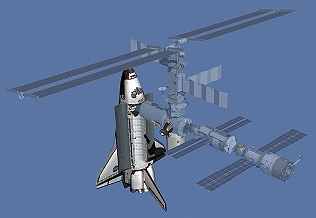 |
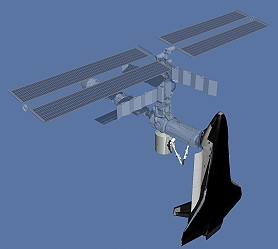 |
 |
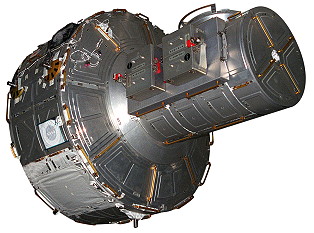 |
Photos / Graphics
 |
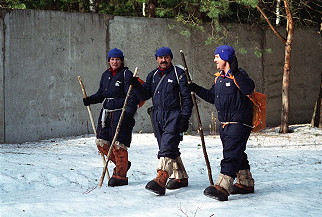 |
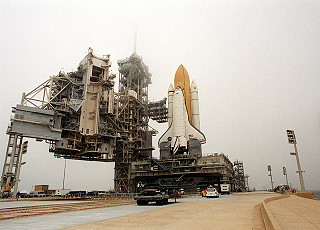 |
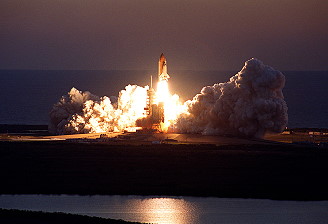 |
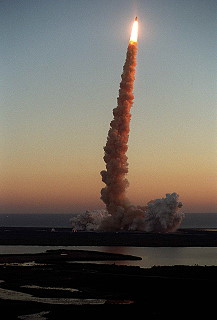 |
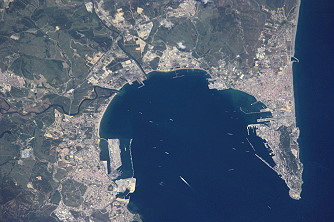 |
 |
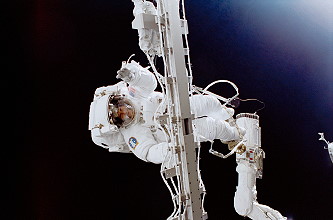 |
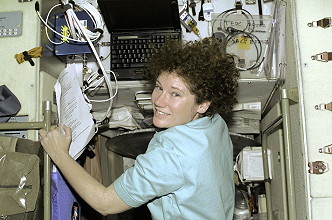 |
 |
 |
 |
 |
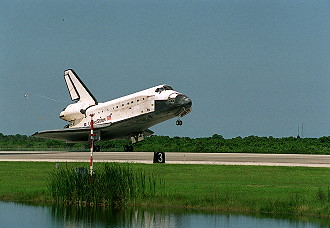 |
more Earth observation photos |
|
more onboard photos |
|
| © |  |
Last update on December 12, 2020.  |
 |